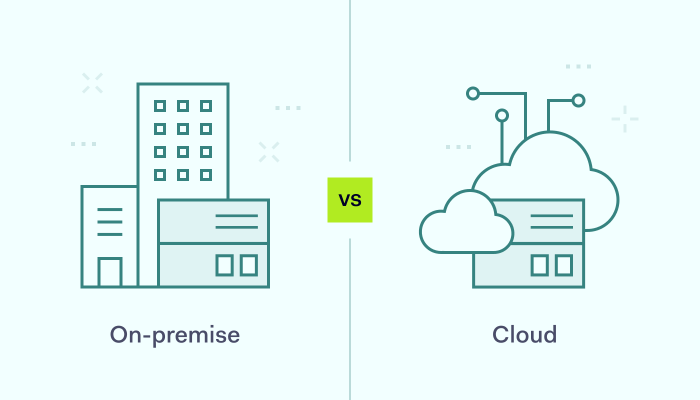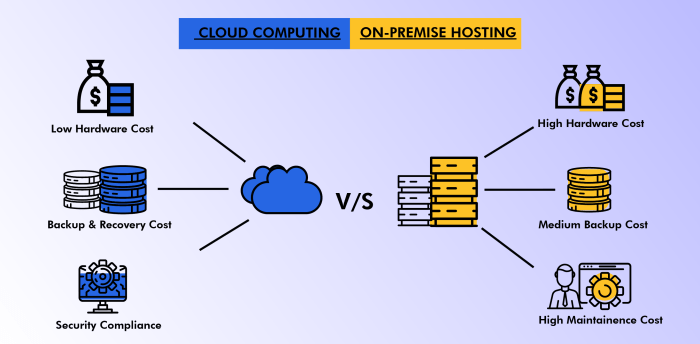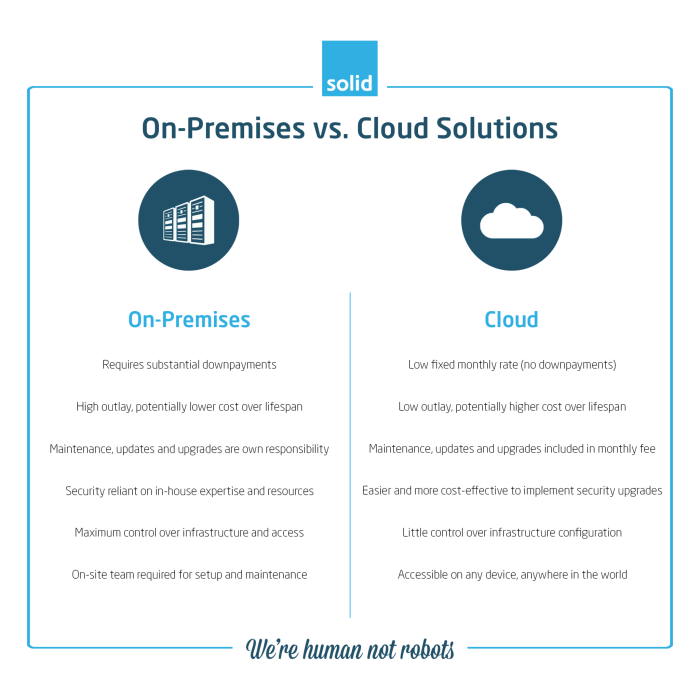What are the advantages of cloud-based ERP systems over traditional on-premise solutions sets the stage for this enthralling narrative, offering readers a glimpse into a story that is rich in detail and brimming with originality from the outset.
In today’s rapidly evolving business landscape, companies are constantly seeking ways to optimize their operations and gain a competitive edge. Enterprise Resource Planning (ERP) systems play a crucial role in streamlining processes, managing data, and improving efficiency. While traditional on-premise ERP solutions have been the mainstay for many years, cloud-based ERP systems are gaining increasing popularity due to their numerous advantages.
This article delves into the key benefits of cloud ERP, exploring how they can empower businesses to achieve greater agility, cost-effectiveness, and scalability.
Cost Savings

Implementing an on-premise ERP system requires a significant upfront investment, encompassing hardware, software licenses, and installation. This traditional approach can be a substantial financial burden for businesses, especially those with limited resources or a desire for greater flexibility. In contrast, cloud-based ERP systems offer a subscription-based model, eliminating the need for large upfront investments and reducing overall IT expenditure.
Cost Savings Associated with Cloud-Based ERP Systems, What are the advantages of cloud-based ERP systems over traditional on-premise solutions
The subscription model eliminates the need for substantial upfront investments in hardware, software licenses, and installation, which are typically associated with on-premise solutions. This allows businesses to allocate their capital more strategically, focusing on core operations and growth initiatives.
- Reduced Hardware Costs: Cloud-based ERP systems eliminate the need for expensive servers, storage devices, and other hardware components, as all infrastructure is managed and maintained by the cloud provider. This significantly reduces capital expenditure and ongoing maintenance costs.
- Lower Software License Costs: Cloud-based ERP systems often offer a subscription-based pricing model, where businesses pay a monthly or annual fee for access to the software. This eliminates the need for large upfront license purchases, making it a more affordable option for businesses of all sizes.
- Elimination of Installation Costs: On-premise ERP systems require significant time and resources for installation, configuration, and integration with existing systems. Cloud-based solutions are typically pre-configured and ready to use, eliminating the need for costly installation processes.
Cost Savings Related to Maintenance and Upgrades
On-premise ERP systems require ongoing maintenance, including software updates, security patches, and hardware upgrades. These maintenance activities can be time-consuming and costly, requiring specialized IT staff and resources. Cloud-based ERP systems offer significant advantages in this regard, as the cloud provider handles all maintenance and upgrades, ensuring that businesses always have access to the latest software versions and security updates.
- Automated Updates and Upgrades: Cloud-based ERP systems are automatically updated and upgraded by the cloud provider, eliminating the need for manual interventions and reducing the risk of downtime. This ensures that businesses always have access to the latest features and security enhancements.
- Reduced Maintenance Costs: By outsourcing maintenance and upgrades to the cloud provider, businesses can significantly reduce their IT expenditure. This frees up internal resources to focus on core business activities, improving efficiency and productivity.
- Lower Support Costs: Cloud-based ERP systems typically include comprehensive support services, such as technical assistance, troubleshooting, and training. This reduces the need for businesses to hire and maintain their own IT support staff, further lowering overall costs.
Integration and Automation

Cloud-based ERP systems excel in integration and automation, offering businesses significant advantages over traditional on-premise solutions. Their inherent design allows for seamless connection with various applications and services, simplifying workflows and enhancing efficiency.
Integration with Other Applications and Services
Cloud-based ERP systems are designed to integrate seamlessly with other business applications and services. This allows businesses to create a unified ecosystem where data flows freely between different systems, eliminating data silos and improving decision-making. Here are some examples of how cloud-based ERP systems can integrate with other applications:
- Customer Relationship Management (CRM): Integrating an ERP with a CRM system enables businesses to manage customer interactions, track sales opportunities, and gain a comprehensive view of customer relationships.
- E-commerce Platforms: Integration with e-commerce platforms allows businesses to manage online orders, inventory levels, and customer data directly within the ERP system.
- Payment Gateways: ERP systems can integrate with payment gateways to process online payments, manage transactions, and reconcile accounts.
- Accounting Software: Integrating with accounting software ensures accurate financial reporting, simplifies reconciliation, and streamlines financial processes.
Automation Features
Cloud-based ERP systems are equipped with powerful automation features that streamline business processes and reduce manual effort. These features can automate repetitive tasks, improve accuracy, and free up valuable time for strategic initiatives.
- Workflow Automation: Automating workflows allows businesses to define and manage processes, such as approval requests, order fulfillment, and invoice processing, automatically. This eliminates manual intervention, reduces errors, and speeds up task completion.
- Data Synchronization: Cloud-based ERP systems enable real-time data synchronization across all connected applications. This ensures data consistency, eliminates discrepancies, and provides access to the most up-to-date information.
- Reporting and Analytics: Automated reporting and analytics features generate insights from data, providing businesses with valuable information to make informed decisions.
Comparison with Traditional On-Premise Solutions
Traditional on-premise ERP systems often require significant customization and integration efforts to connect with other applications. This can be a complex and time-consuming process, with ongoing maintenance and support costs. In contrast, cloud-based ERP systems are designed for seamless integration and automation. They leverage pre-built integrations and APIs, simplifying the connection process and reducing development time and costs.
Furthermore, cloud providers often manage the integration and automation aspects, reducing the burden on businesses.
Updates and Maintenance: What Are The Advantages Of Cloud-based ERP Systems Over Traditional On-premise Solutions

Cloud-based ERP systems offer a significant advantage over traditional on-premise solutions in terms of updates and maintenance. Unlike on-premise systems that require manual intervention for updates and upgrades, cloud-based ERP systems are automatically updated and maintained by the vendor. This means that users always have access to the latest features, functionalities, and security patches without needing to download, install, or configure anything.
This automated approach simplifies the update process and eliminates the need for dedicated IT resources to manage updates.
Automatic Updates and Maintenance
Cloud-based ERP vendors continuously develop and release updates to improve their software and address any security vulnerabilities. These updates are automatically applied to all users’ systems, ensuring that everyone benefits from the latest enhancements. This eliminates the need for manual updates, which can be time-consuming and disruptive.
Benefits of Continuous Updates
Continuous updates provide several benefits, including:* Enhanced Security: Regular updates address security vulnerabilities, protecting your data from unauthorized access and cyber threats.
Improved Functionality
Updates introduce new features and functionalities, enhancing your ERP system’s capabilities and allowing you to optimize business processes.
Reduced Downtime
Automatic updates minimize downtime and ensure that your system remains operational and accessible.
Cost Savings
Eliminating the need for manual updates reduces IT costs and frees up resources for other critical tasks.
Comparison with Traditional On-Premise Solutions
In contrast to cloud-based ERP systems, traditional on-premise solutions require manual updates and maintenance. This process typically involves:* Downloading and installing updates: Users must manually download and install updates, which can be time-consuming and require specialized IT knowledge.
Testing and validation
After installation, updates need to be tested and validated to ensure they work correctly with existing configurations and data.
Potential downtime
Updates can cause downtime, interrupting business operations and affecting productivity.
Higher IT costs
Managing updates and maintenance for on-premise ERP systems requires dedicated IT resources, increasing costs.
Automatic updates in cloud-based ERP systems ensure that users always have access to the latest features, functionalities, and security patches, without requiring manual intervention.
The transition from on-premise to cloud-based ERP systems presents a compelling opportunity for businesses to unlock a world of possibilities. By embracing the flexibility, scalability, and cost-efficiency of cloud solutions, organizations can streamline operations, enhance data security, and empower their workforce to achieve new levels of productivity. The future of ERP is undeniably in the cloud, and businesses that make the shift early will be well-positioned to thrive in the dynamic digital age.
Key Questions Answered
What are the main differences between cloud-based and on-premise ERP systems?
The primary difference lies in the deployment model. Cloud-based ERP systems are hosted on remote servers and accessed over the internet, while on-premise systems are installed and maintained on a company’s own servers. This difference leads to variations in cost, security, scalability, and other aspects.
Is cloud ERP suitable for all businesses?
While cloud ERP offers significant benefits, it may not be suitable for all businesses. Companies with highly sensitive data or stringent regulatory requirements might prefer on-premise solutions for greater control. However, cloud ERP has become increasingly sophisticated and secure, making it a viable option for a wide range of businesses.
How do I choose the right cloud ERP system for my business?
Choosing the right cloud ERP system requires careful consideration of your business needs, budget, industry, and size. It’s essential to research different vendors, compare features, and assess their security and compliance measures.
What are the risks associated with cloud ERP?
While cloud ERP offers numerous advantages, there are also potential risks, such as data security breaches, vendor lock-in, and internet connectivity issues. It’s crucial to select a reputable vendor with robust security protocols and a comprehensive service level agreement.
How can I migrate from on-premise ERP to cloud ERP?
Migrating to cloud ERP involves a multi-step process that requires careful planning and execution. It’s advisable to engage with a trusted IT partner or consultant who can guide you through the migration process and ensure a smooth transition.